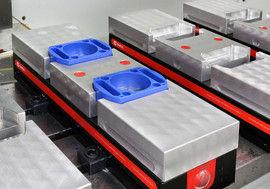


Subcontractor’s detailed examination of workholding reveals astonishing cost savings and productivity increases
No matter how fast a machining centre is, the speed and efficiency with which parts can be clamped for presentation to the spindle and unclamped afterwards defines the productivity of a process.
A prime example is at Gosport-based subcontractor and precision engineering firm, QCD Limited, where huge benefits are being gained using US-made Chick Workholding twin-station workholding devices supplied by UK agent, 1st Machine Tool Accessories.
Established in 2000, QCD mainly serves the cosmetics, pharmaceutical, defence, nuclear, motor sport and aerospace industries. Owner and managing director, Steve Lindsell, has gone into great detail evaluating the cost savings and productivity increases resulting from the new clamping arrangement.
Overall, £50,000 per year is being saved using five Chick Qwik-Lok workholding units from 1st MTA, compared with when components were secured in the same number of traditional wind-up vices. As the new clamps cost just £6,000, the investment was amortised in a month and a half – precisely 46 days after delivery.
The subcontractor specialises in using a Faro arm to reverse engineer and supply parts for production machinery more cheaply and quickly than OEMs in Germany and Italy. The required finish on some plastic components, for example, is high at 8 CLA and dimensional tolerance is typically ± 0.05 mm. Batch sizes are between 100- and 500-off and turnaround time is normally two or three days, but is sometimes within one day if a broken component has stopped a production line.
Hurco VMCs (vertical machining centres) carry out all of the prismatic machining at Gosport and it is on the table of a 3-axis VM3 model that the five twin-station Qwik-Loks provide 10 clamping positions. Mr Lindsell has worked out that by fixturing 10 parts at a time rather than one, cycle time per part is halved, typically from four minutes down to two. This is achieved by consolidating the time for half a dozen tool changes across all of the parts and reducing ATC time by a factor of 10.
Some parts require up to six separate operations, in which case they go individually onto a 4-axis VMC and/or a Mazak CNC lathe. 5-axis prismatic machining has been considered, but cannot get close to the low cycle time per part achieved by the 10-at-a-time strategy.
The aforementioned plastic components undergo a roughing operation (Op 1) held in hard jaws on five conventional twin-station vices on another VMC. The jaws are not changed to suit different sizes and shapes of component and so this first operation is cost effective.
The parts are transferred to the five Qwik-Loks on the VM3 for finish milling and drilling (Op 2) while held in soft aluminium jaws machined to match the shape of the component.
The jaws snap on and off quickly using Chick’s System 5 Qwik-Change technology. They can be turned around to allow another shape of part to be held by a differently machined face on the other side of the jaw or are replaced by an entirely different set of jaws.
Mr Lindsell commented, “Repeatability of positioning on the Qwik-Loks from 1st MTA is excellent, which means that components are machined more accurately. Five complete changeovers are achieved in just 15 minutes. This is our biggest cost saving. With the type of twin vice we use for Op 1, it used to take a whole day to change over a set of soft jaws and clock them into position for Op 2.
“Then we might only produce 100-off and have to change the jaws back again. It was a recipe for losing money.”
Saving up to eight hours setting up each new job for Op 2 translates into a big part of the £50,000 annual saving that results from using the Qwik-Loks.
Another major factor is a reduction in swarf management. QCD staff used to spend up to a quarter of their time blowing swarf away from the working area with compressed air, even after incorporating the operation of a spindle-mounted chip fan into the machining cycle.
Comprehensive swarf removal was needed due to the large number of traps in conventional vices for harbouring chips, which if not removed would compromise machining accuracy.
Manual swarf removal is no longer necessary with the Chick clamps, as their working parts are fully enclosed and protected from swarf and coolant ingress.
The third major area for savings is also related to the sealed construction of the Qwik-Lok clamps. It has eliminated the need to dismantle them three or four times a year to clean out the swarf and de-rust the leadscrews, which takes four operator-days each time when cleaning a set of five conventional vices.
Mr Lindsell concluded, “The 1st MTA clamping solution based on Chick Qwik-Loks is saving us a considerable amount of money, which helps us to keep down the prices we charge customers and improve our competitiveness.”
The full range of Chick System 5 products are available from 1st MTA. If you have any questions or queries about the products mentioned in this article, please don’t hesitate to contact us on 0800 783 0510 or enquiries@1mta.com.